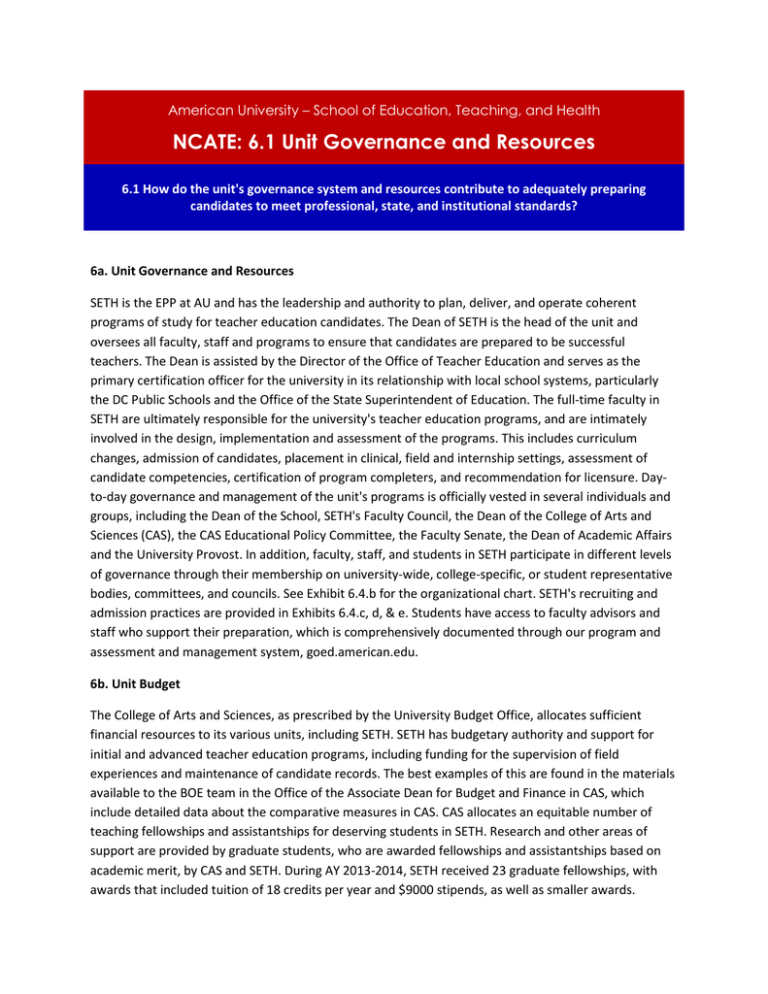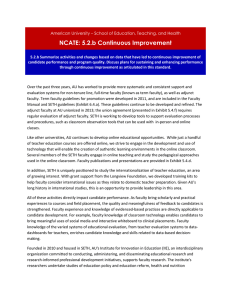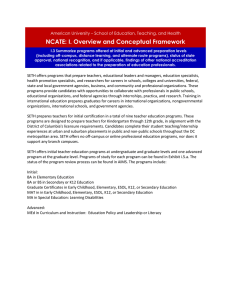NCATE: 6.1 Unit Governance and Resources
advertisement

American University – School of Education, Teaching, and Health NCATE: 6.1 Unit Governance and Resources 6.1 How do the unit's governance system and resources contribute to adequately preparing candidates to meet professional, state, and institutional standards? 6a. Unit Governance and Resources SETH is the EPP at AU and has the leadership and authority to plan, deliver, and operate coherent programs of study for teacher education candidates. The Dean of SETH is the head of the unit and oversees all faculty, staff and programs to ensure that candidates are prepared to be successful teachers. The Dean is assisted by the Director of the Office of Teacher Education and serves as the primary certification officer for the university in its relationship with local school systems, particularly the DC Public Schools and the Office of the State Superintendent of Education. The full-time faculty in SETH are ultimately responsible for the university's teacher education programs, and are intimately involved in the design, implementation and assessment of the programs. This includes curriculum changes, admission of candidates, placement in clinical, field and internship settings, assessment of candidate competencies, certification of program completers, and recommendation for licensure. Dayto-day governance and management of the unit's programs is officially vested in several individuals and groups, including the Dean of the School, SETH's Faculty Council, the Dean of the College of Arts and Sciences (CAS), the CAS Educational Policy Committee, the Faculty Senate, the Dean of Academic Affairs and the University Provost. In addition, faculty, staff, and students in SETH participate in different levels of governance through their membership on university-wide, college-specific, or student representative bodies, committees, and councils. See Exhibit 6.4.b for the organizational chart. SETH's recruiting and admission practices are provided in Exhibits 6.4.c, d, & e. Students have access to faculty advisors and staff who support their preparation, which is comprehensively documented through our program and assessment and management system, goed.american.edu. 6b. Unit Budget The College of Arts and Sciences, as prescribed by the University Budget Office, allocates sufficient financial resources to its various units, including SETH. SETH has budgetary authority and support for initial and advanced teacher education programs, including funding for the supervision of field experiences and maintenance of candidate records. The best examples of this are found in the materials available to the BOE team in the Office of the Associate Dean for Budget and Finance in CAS, which include detailed data about the comparative measures in CAS. CAS allocates an equitable number of teaching fellowships and assistantships for deserving students in SETH. Research and other areas of support are provided by graduate students, who are awarded fellowships and assistantships based on academic merit, by CAS and SETH. During AY 2013-2014, SETH received 23 graduate fellowships, with awards that included tuition of 18 credits per year and $9000 stipends, as well as smaller awards. Graduate students are also eligible for federal work-study awards for up to 20 hours/week. Students are assigned teaching assistant, research, or service duties to support faculty, based on the students' academic endeavors and past professional experience, and in a manner mindful of enriching the students' academic experience at AU. In addition, SETH houses a number of grants and contracts that generate funds to support instruction and support activities, either directly or through indirect cost recoveries. Using the indirect overhead charged on grants, SETH has created a scholarship fund for graduate students while supporting additional professional development and research activities for faculty and candidates. 6c. Personnel In SETH, a regular teaching load for a research active, full-time, tenure-line faculty member is on average four 3-credit hour courses during an academic year. Term faculty typically teach a total of six 3-credit hour courses per year, with no more than 9 credit hours per semester. Specific teaching loads for SETH faculty are determined by a number of factors, including a faculty member's responsibilities and his or her unique and diverse experiences. A description of these factors can be found in the AU Faculty Manual and SETH evaluation criteria in Exhibit 6.4.a. The teaching loads and workload reports are reported in Exhibit 6.4.h. Class limits are determined with the CAS Deans Office and differ for elective, general education, undergraduate requirements, and graduate elective and required courses. Full and part-time clinical faculty supervise student teachers, with no more than 4 candidates supervised in any given semester. SETH's clinical supervision workload model is presented in exhibit 3.4.d. In addition to course load, SETH faculty keep regular office hours for student advising as outlined in the manuals in Exhibit 6.4.a. Beyond these responsibilities, faculty who advise in teacher education programs are members of the SETH Undergraduate and Teacher Education Committee. All faculty in SETH serve on other committees in SETH, the University Senate, or in CAS; most faculty members are also involved in service to the community as well as to the University. Exhibit 5.4.e provides details regarding SETH faculty service activities. Professional development and technology training for faculty is supported by the Center for Teaching, Research and Learning. Links to these materials can be found in Exhibit 6.4.j. AU's facilities as of fall 2013 comprise almost 4,000,000 square feet of area, in 54 on-campus buildings and several off-campus buildings. The facilities are comprehensive and represent typical university uses. They include 140 instructional spaces, libraries, a student center, athletic and recreation facilities, a theatre, an art museum, and many other specialized facilities. In addition to new facilities, there have also been adaptations of existing facilities to meet the university's evolving needs. New research labs for biology and behavioral neuroscience have been created in existing buildings to support the increased emphasis on research and science education. Faculty offices have been added to support the significant growth in faculty over the last five years. The main offices of SETH are in Gray Hall, with additional offices and space in the Mary Graydon Center, which was renovated in the spring of 2014 to accommodate SETH faculty and staff. In addition to offices of 24 faculty and 12 staff members, Gray Hall also includes two multi-purpose classrooms controlled by SETH (one is shared with the Math Department), a conference room, and adequate storage space. University classes, including those in professional education, meet across the universities campus in a variety of the 16 buildings with classroom facilities. Assignment of classrooms is made according to the demands of the courses, faculty needs, and student needs. Many University classroom facilities are new, including a large number of classrooms with audio-visual and computer-aided technology. The majority of classrooms are equipped with permanent faculty podiums, overhead projectors, and internet access. 6e. Unit Resources including Technology Faculty and candidates in SETH's teacher education programs have access to a substantial array of university resources to support their activities, particularly in the University Library, the Center for Teaching, Research & Learning, the Office of Institutional Assessment, and the Office of Information Technology. Resources in the University's Office of Information Technology A major challenge faced by institutions like AU is the demand and cost of technology. Information technology (IT) resources have improved significantly in the past few years in direct response to the growing demand for technological infrastructure and services. In 2008, a multiyear strategic roadmap was outlined for IT, which is included in Exhibit 6.4.i. The roadmap targeted building out key infrastructure and competencies, focusing on systems, processes, and people. Since then, numerous key processes have been instituted internally, such as change management, asset management, project management, service management, incident management, and problem management. Much of the infrastructure has been consolidated and standardized, resulting in a more stable and manageable architecture. Legacy systems have been replaced with industry-recognized enterprise-level systems. The campus now has adopted many new enterprise systems, including a robust content management system, a portal, a collaboration platform, enhanced administrative and student information systems, a business intelligence platform, an integrated messaging system, a storage area network, a firewall, and a network access control system. Resources in the University Library The University Library provides reference support, orientation, instruction, and research assistance to meet the information and technology needs of students. In recent years the library has expanded its online tutorials and provides laptops and other technology for students working in the library. Reference support is available online through live chat for students outside the library. The library is open 24 hours a day with staff support available until midnight Sunday through Thursday evenings and until 9 p.m. on Fridays and Saturdays. Surveys of library use from midnight to 8 a.m. reveal the popularity of these hours for student academic study. Student satisfaction with library service is consistently positive and in the 2013 Campus Climate Survey, the university library received excellent or good ratings from undergraduates. The education and teacher education collections are selected by faculty, in collaboration with a full-time faculty librarian, Alex Hodges, an education subject specialist. Mr. Hodges is the Curriculum Materials and Education Librarian for Reference and Instruction and a tenured faculty member in the library with an affiliate appointment in SETH.


